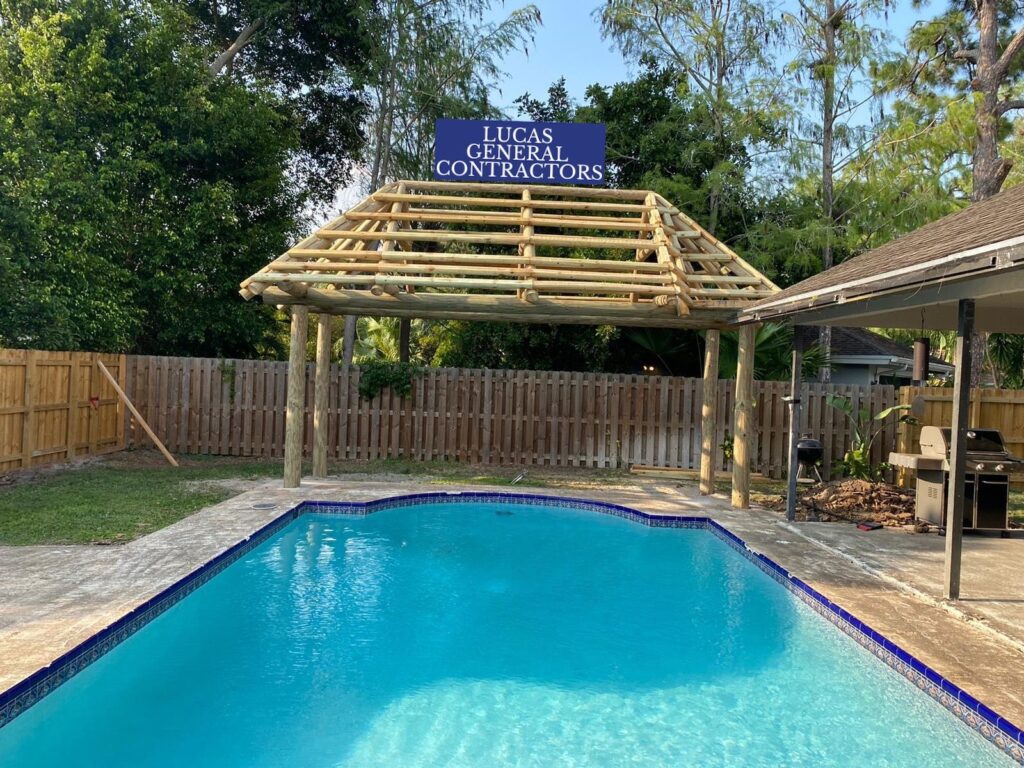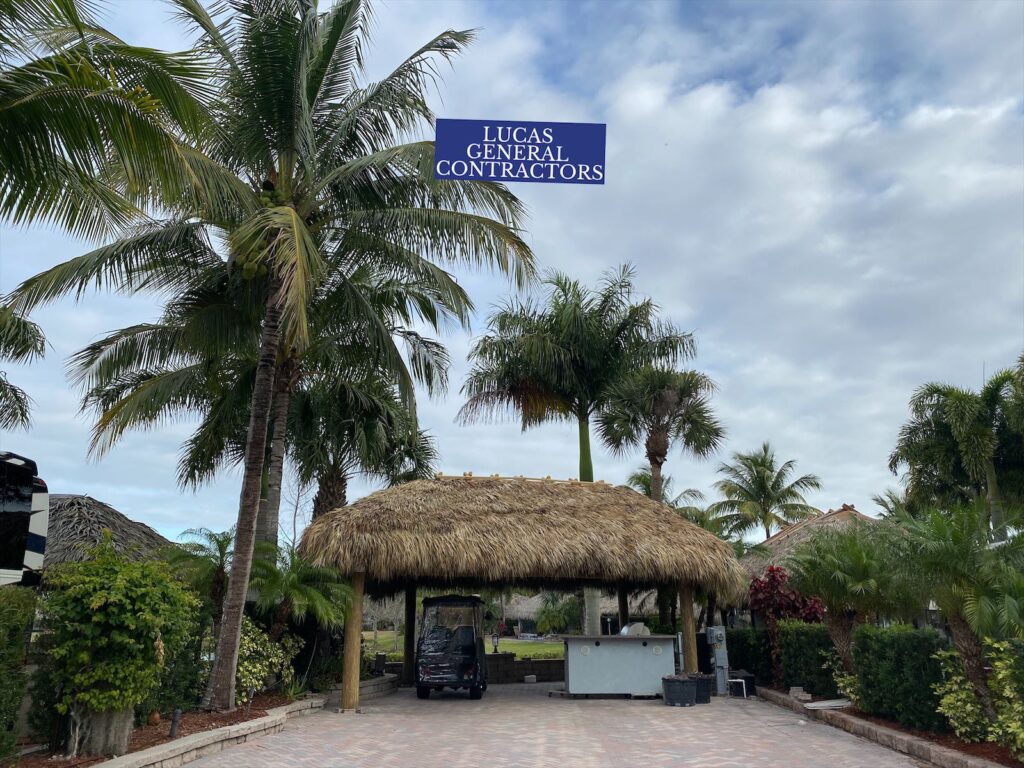Florida’s tropical climate makes it an ideal place for tiki huts, but the state’s hurricane season often brings severe weather that can damage these structures. From high winds to torrential rains, hurricanes can tear apart thatched roofs and weaken the overall integrity of your tiki hut. If your tiki hut has sustained damage during this time, it’s crucial to know how to assess the damage and begin the repair process as soon as possible.
In this complete guide, we’ll walk you through the steps to repairing and restoring your tiki hut after hurricane season, including your options for rethatching with either natural or synthetic materials. Whether you’re in Port St. Lucie, Fort Myers, or Okeechobee, our expert team at Lucas General Contractors is here to help you get your tiki hut back in top shape.
1. Assessing Hurricane Damage to Your Tiki Hut
The first step after any hurricane is to assess the damage to your tiki hut. High winds and flying debris often cause tears in the thatched roof, while heavy rainfall can lead to water damage. Begin by examining the thatch—look for missing or frayed sections, as well as any areas where the roof has been compromised, leaving the wood beneath exposed to moisture.
Check the structure itself for signs of weakening, such as cracks in the support beams or dislodged poles. Water intrusion can also cause the wood to rot, particularly if the thatch was severely damaged during the storm. By thoroughly inspecting your tiki hut, you can determine whether a full rethatch or targeted repairs are needed.
2. Choosing Between Natural Thatch and Synthetic Thatch for Repairs
When it comes to rethatching your tiki hut after a storm, you have two main options: natural thatch or synthetic thatch. Both options have their benefits, and the best choice depends on your budget, maintenance preferences, and the longevity you expect from your tiki hut roof.
- Natural Thatch:
- Natural thatch is the traditional material used for tiki hut roofs, offering a classic tropical look that blends seamlessly with the Florida environment. This material typically lasts between 4 to 6 years, depending on exposure to the elements and how well it’s maintained. Natural thatch is ideal for those seeking an authentic, organic aesthetic for their tiki hut.
- While natural thatch is more affordable upfront, it requires more frequent maintenance and eventual replacement after several years. If you prefer the look of traditional tiki huts and don’t mind the maintenance, natural thatch is a great choice for repairs after a hurricane.
- Synthetic Thatch:
- For those seeking a more durable, long-lasting option, synthetic thatch is an excellent alternative. Synthetic thatch can last for 20+ years, making it a low-maintenance solution for tiki hut owners. While the initial cost is approximately three times as much as natural thatch, the longevity and reduced need for repairs make it a cost-effective option in the long run.
- Synthetic thatch is designed to withstand Florida’s harsh weather conditions, including hurricanes, heavy rainfall, and strong UV exposure. If you’re looking to minimize future rethatching and ensure your tiki hut remains storm-resistant, synthetic thatch is the way to go.
3. Repairing or Replacing the Thatch Roof
Once you’ve assessed the damage and decided between natural or synthetic thatch, the next step is to repair or replace the thatched roof. If the damage is minimal, such as a few torn sections, you may be able to patch the roof with new thatch. However, if a significant portion of the roof is damaged, a complete rethatch may be necessary.
For natural thatch, it’s important to choose high-quality materials to ensure the roof lasts as long as possible. Synthetic thatch, on the other hand, offers a more durable and uniform appearance, making it an attractive option for those who want to protect their tiki hut from future hurricanes.
4. Strengthening the Tiki Hut’s Structure
Hurricanes can weaken the structure of your tiki hut, especially if high winds have caused shifts in the support beams or poles. In addition to repairing the thatch, it’s essential to check the structural integrity of the hut. Replace any cracked or damaged beams and consider reinforcing the frame with stronger materials to better withstand future storms.
If your tiki hut has been through multiple hurricane seasons, it may be worth upgrading the structure with wind-resistant fasteners or cross-bracing to improve stability. Strengthening the structure now can save you from more costly repairs after the next storm.
5. Waterproofing and Treating the Wood
Water damage is a common issue after hurricanes, especially when the thatch has been torn away, leaving the wood exposed to the elements. After repairing the thatch and reinforcing the structure, apply a waterproof sealant to protect the wooden beams and poles from future moisture.
Additionally, treating the wood with a termite and pest deterrent is recommended, particularly in Florida’s humid climate. These treatments help preserve the wood and extend the life of your tiki hut, ensuring it stays in excellent condition between rethatches.
6. Regular Maintenance to Prepare for Future Hurricane Seasons
Even after you’ve repaired your tiki hut, regular maintenance is essential to keep it in top condition. Florida’s tropical climate and hurricane season mean that wear and tear is inevitable. Schedule regular inspections of your tiki hut to identify any minor damage before it becomes a bigger issue.
For natural thatch, periodic maintenance is necessary to replace worn sections and ensure the roof remains tight and secure. Synthetic thatch, while more durable, also benefits from regular checks to ensure it stays free of debris and remains firmly in place.
By maintaining your tiki hut year-round, you can avoid costly repairs and ensure it stays hurricane-resistant.

Rethatch and Restore Your Tiki Hut with Lucas General Contractors
After hurricane season in Florida, your tiki hut may need some attention. Whether you choose natural thatch for its traditional look or synthetic thatch for its durability and long lifespan, repairing and rethatching your tiki hut is essential to maintaining its beauty and functionality.
At Lucas General Contractors, we specialize in tiki hut repairs and rethatching, offering both natural and synthetic thatch options to suit your needs. Our team of experts will assess your hut, provide recommendations, and ensure it’s restored to withstand future storms. Contact us today for a free consultation and protect your tiki hut from the elements.
We proudly serve the following areas:
Bradenton | Sarasota | Venice | North Port | Port Charlotte | Punta Gorda | Fort Myers | Cape Coral |
Bonita Springs | Estero | Naples | Marco Island | Lehigh Acres | St. Petersburg | Immokalee | Labelle | Okeechobee |
Sebring | Lake Placid | Arcadia | Clewiston | Moore Haven | Englewood | Rotonda West | Golden Gate | Sanibel |
Fort Myers Beach | Alva | Bokeelia | Matlacha | Saint James City | Sebastian | Vero Beach | Fort Pierce |
Port St. Lucie | Stuart | Hobe Sound | Tequesta | Jupiter | Clearwater

